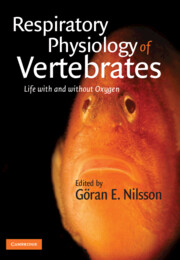1 - Introduction: why we need oxygen
Published online by Cambridge University Press: 05 June 2012
Summary
The aim of this book is not only to describe the basic functions of the respiratory systems of vertebrates, and the diversity in these functions among vertebrates, but also to examine adaptations in these systems that allow numerous vertebrates to explore more or less extreme environments in which oxygen availability is limited or in which there is no oxygen at all.
For the organism to be able to respond to variable oxygen levels, it needs to be able to sense oxygen. This can be done either directly, by monitoring the level of O2, or indirectly, by responding to changes in the energy status of tissues or cells. Even if some oxygen-sensing structures and their functions have been examined relatively thoroughly, such as the oxygen-sensing carotid bodies in mammals, it is clear that many mechanisms related to oxygen sensing are still largely unknown, particularly when it comes to the almost mysterious ability of many (perhaps most) cells to detect and respond to changing oxygen levels. Chapter 2 will describe the present state of knowledge in this very active field of research. In Chapters 3–4, we will examine the fundamental functions of the respiratory systems of air-breathing and water-breathing vertebrates, laying out the framework for the final five chapters, which deal with adaptations to particularly challenging situations for vertebrates: life at high altitude, diving, surviving in hypoxic waters, and surviving without any oxygen at all.
- Type
- Chapter
- Information
- Respiratory Physiology of VertebratesLife With and Without Oxygen, pp. 3 - 13Publisher: Cambridge University PressPrint publication year: 2010
References
- 1
- Cited by



